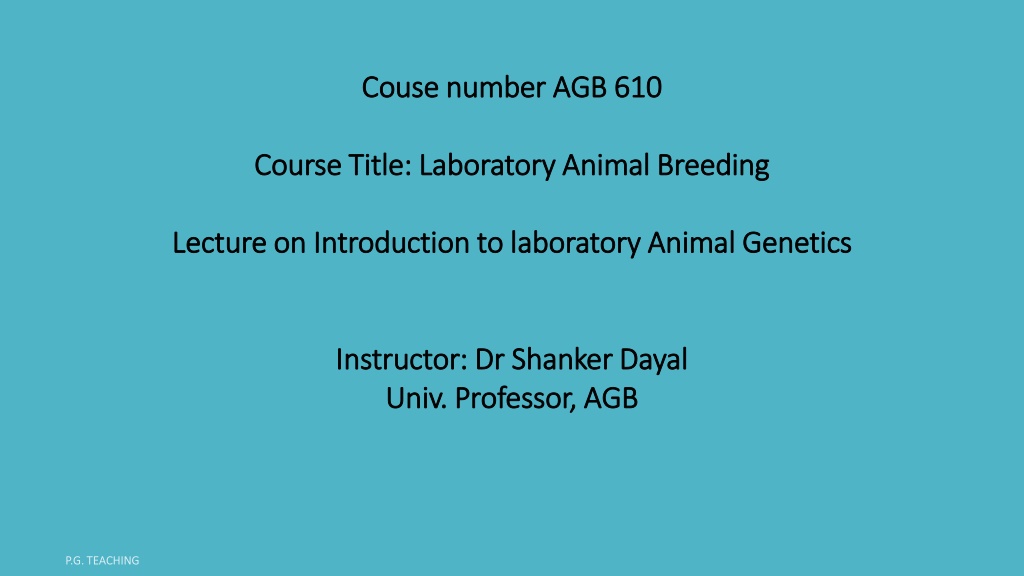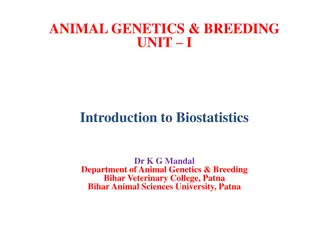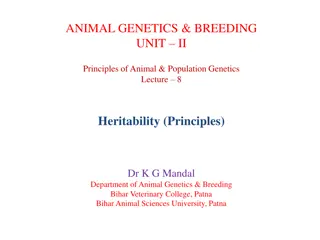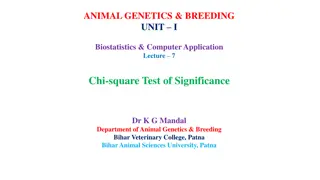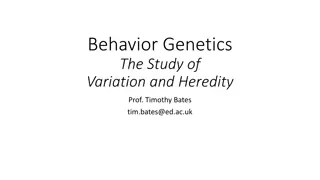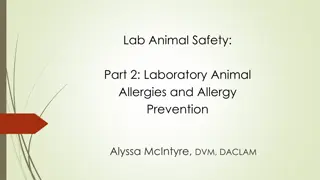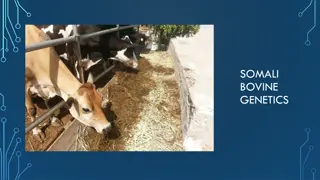Understanding Laboratory Animal Genetics and Research Importance
This course (AGB 610) delves into the realm of laboratory animal breeding, exploring the significance of using animals in research and teaching. Dr Shanker Dayal, a distinguished professor, guides students through lectures on animal genetics and the common uses of laboratory animals. The course emphasizes the similarities between human and animal biology, highlighting the benefits of authentic research results derived from standardized animal models. The categorization of laboratory animals based on health status is also discussed, underscoring the critical role of selecting the appropriate type of animal for scientific studies.
Download Presentation

Please find below an Image/Link to download the presentation.
The content on the website is provided AS IS for your information and personal use only. It may not be sold, licensed, or shared on other websites without obtaining consent from the author. Download presentation by click this link. If you encounter any issues during the download, it is possible that the publisher has removed the file from their server.
E N D
Presentation Transcript
Couse number AGB 610 Couse number AGB 610 Course Title: Laboratory Animal Breeding Course Title: Laboratory Animal Breeding Lecture on Introduction to laboratory Animal Genetics Lecture on Introduction to laboratory Animal Genetics Instructor: Dr Instructor: Dr Shanker Univ. Professor, AGB Univ. Professor, AGB ShankerDayal Dayal
Laboratory animals Laboratory animals: Any vertebrate animal produced for or used in teaching, testing : Any vertebrate animal produced for or used in teaching, testing and research and research Common Use: Common Use: 1. 1. Acquisition of new knowledge Acquisition of new knowledge 2. Development and testing of medicine and vaccine 2. Development and testing of medicine and vaccine 3. To know mechanism of function of animals and human 3. To know mechanism of function of animals and human 4. assessing the effect of chemicals and environmental pollutants on animal 4. assessing the effect of chemicals and environmental pollutants on animal and human and human 5. Used in teaching exercises 5. Used in teaching exercises 6. Used in efficacy, safety and toxicity testing 6. Used in efficacy, safety and toxicity testing
Why to use animals for research and teaching? The The functions functions of of cell human human. . cell and and organs organs are are similar similar in in animals animals and and What What we and and other other animals we learn learn on animals on laboratory laboratory animal animal are are also also useful useful for for human human To To obtain obtain authentic tests, tests, standardised standardised animals status status should should be be used authentic results results of of the animals with used. . the research research experiments with known known health health and experiments and and genetic and genetic Animals Animals of of unknown with with uncertain uncertain repeatability unknown origin repeatability origin are are prone prone to to give give erroneous erroneous results results
Type Type of of laboratory laboratory animal animal on on the the basis basis of of their their health health status status 1. 1. Conventional Conventional 2 2. . Specific Specific pathogen pathogen free free (SPF) (SPF) 3 3. . Germ Germ free free ( (Gnotobiotic Gnotobiotic) ) Conventional Conventional colony from from known known genetic colony free genetic stock free from stock is is acceptable acceptable in in most from common common diseases diseases and most research research. . and drawn drawn SPF SPF and and gnotobiotic gnotobiotic animal animal are are used used for for specific specific research research
For For any animal animal is is essential any scientific scientific research essential to to get research the get good good results the selection selection of of right results. . right type type of of Lab Lab animal animal should animal animal houses houses where under under scientific scientific discipline should always where animals discipline. . always be animals are be obtained obtained from are bred bred and from organised organised and maintained maintained A A number number of of visible physiology, physiology, behaviour interferes interferes with with the unreliable unreliable results results. . visible and behaviour and the experimental experimental responses and invisible invisible factors and health health of of the responses and factors affect the animal animal that and provide affect the the that provide Hence Hence lab lab animal animal need need careful careful breeding breeding and and maintenance maintenance. .
Requirements of Breeding and care of laboratory animals Requirements of Breeding and care of laboratory animals
1. Housing Management: 1. Housing Management: Very sensitive to their living condition therefore should be housed away from human Very sensitive to their living condition therefore should be housed away from human habitations and not exposed to dust, smoke, noise, wild rodents, insects and birds habitations and not exposed to dust, smoke, noise, wild rodents, insects and birds 22 22o oC C 1 1o oC C 50 50- -60% 60% 300 Lux at floor level with regular 12 hr light cycle 300 Lux at floor level with regular 12 hr light cycle 50 50 db db avoid sudden and sharp sound avoid sudden and sharp sound 10 10- -15 air changes/hr 15 air changes/hr Temperature Temperature Humidity Humidity Light Light Noise Noise Ventilation Ventilation Constant temperature is essential as variation in room temperature causes change in Constant temperature is essential as variation in room temperature causes change in food/water intake and also effect fertility and lactation. food/water intake and also effect fertility and lactation. Increase in temperature with high humidity causes ammonia built up predisposing them to Increase in temperature with high humidity causes ammonia built up predisposing them to opportunistic infections by lowering their resistance. opportunistic infections by lowering their resistance. Sudden and sharp sound disturb the physiology of animals and may give rise to ear damage, Sudden and sharp sound disturb the physiology of animals and may give rise to ear damage, hypertension, cannibalism hypertension, cannibalism etc etc
2. Breeding and Genetics Breeding and Genetics Breeding Breeding stock stock must must be be procured procured from from a a reliable/accredited reliable/accredited source source Their Their genetic genetic make make up up and and health health should should be be known known Laboratory Laboratory animal to to two two categories categories 1 1. . Outbred Outbred or or random 2 2. . Inbred Inbred strain strain animal on on the the basis basis of of their their genetic genetic make make up up can can be be devided devided in in random bred bred strain strain In In outbred outbred colonies colonies each each individual individual is is genetically genetically unique unique Outbred Outbred stock sub sub optimal optimal condition Eg Eg. . Swiss Swiss mice, mice, Wistar stock are condition Wistar rat are usually usually hardy hardy and and prolific prolific and and usually usually breed breed well well under under rat etc etc
Inbred strain is produced as a result of 20 or more consecutive generation of brother X sister mating In In Inbred Inbred strain strain all all animals animals are breeding breeding pair pair in in 20 20th th or or subsequent subsequent generation are trace trace back generation back to to a a single single In In case case of of an gene gene distribution distribution and be be known known for for further an inbred inbred strain, strain, the and number number of of inbred further propagation propagation. . the character character of of the inbred generation the strain, strain, their generation must their must Inbred Inbred strain contamination contamination. . strain need need careful careful breeding breeding to to avoid avoid any any genetic genetic
3. Nutrition and feeding Nutrition and feeding Should Should be be maintained nutritional nutritional requirement requirement of of each maintained on on balanced balanced diet each species species. . diet based based on on Feed Feed ingredients ingredients used and and free free from from dust, used in in diet dust, moulds, moulds, fungi diet should should be fungi and be of of standard standard quality and other other contaminants contaminants. . quality Commercial Commercial available species species of of animals animals are available pelleted are available pelleted feeds available and feeds balanced balanced for and can can be be used for different different used.
4. Hygiene and disease control Lab Lab animal animal facility facility should the the entry entry of of contaminants contaminants. . should be be provided provided with with barriers barriers at at entry entry to to control control Animal Animal room with with empty empty cages room should should be cages and be cleaned cleaned decontaminated decontaminated and and racks racks regularly regularly and fumigated fumigated along along On On exit established established to to monitor exit side side an an efficient efficient monitoring monitor the the prevalence prevalence of of any monitoring service service is is needed any infection infection in in the needed to to be the colony colony. . be Regular Regular medical medical check check- -up up of of the the animal animal and and staff staff is is essential essential All All dead dead animals off/ off/incenerated incenerated. . animals and and waste waste should should be be properly properly disposed disposed
5. Personnel Management Only Only willing willing staff staff who who have have liking liking for for the the animal animal should should be be recruited recruited Training Training of of staff staff at at all all level level should should be be provided provided They They should should be rooms rooms. . be provided provided protective protective clothing clothing while while working working in in animal animal Regular Regular medical disease disease if if any medical check any check up up should should be be arrange arrange to to diagnose diagnose zoonotic zoonotic
6. Records and evaluation 6. Records and evaluation Record keeping is must for an animal house for evaluation Record keeping is must for an animal house for evaluation Form should be simple and complete Form should be simple and complete Record of breeding and Record of breeding and deathbs deathbs at various stages are essential at various stages are essential Log book of various machines Log book of various machines eg be maintained. be maintained. eg. Incinerator, boiler, A.C. plant should . Incinerator, boiler, A.C. plant should Monthly and annual review of animal house is essential for future Monthly and annual review of animal house is essential for future planning planning
Common Inbred Rat strain Common Inbred Rat strains s ACI ACI Disease Disease model tumours tumours of of testis ipsilateral ipsilateral agenesis for for the the embryologic embryologic origin Disease Disease model model for urinary urinary bladder bladder carcinoma, carcinoma, carcinoma, yolk yolk sac tumours tumours. . Used Used for Disease Disease model model for tumours tumours. . Disease Disease model model for lesions lesions in in 80 80% % of of males model for testis occurs agenesis of of the for congenital congenital genitourinary occurs in in 85 85% % males the kidney kidney ductus origin of of the the caput for Phenylketonuria, Phenylketonuria, interstitial carcinoma, peripheral peripheral retinal sac carcinoma carcinoma. . Will for long long tern tern study study of of xenobiotic for multiple multiple sclerosis sclerosis. . Host genitourinary anomalies males over over 18 ductus and and deferens caput epididymidis epididymidis. . interstitial cell retinal degeneration Will grow grow many many type xenobiotic toxicity Host for anomalies. . Interstitial 18 months, months, ACI deferens serve serve as as models Interstitial cell ACI rats rats with cell with models F344 F344 cell tumour tumour of of the degeneration. . Esophageal type of of transplantable transplantable toxicity. . for many many transplantable transplantable the testis, testis, Esophageal LEW LEW SHRSP SHRSP for Malignant Malignant hypertension, males over over 100 100 days hypertension, stroke days of of age age. . stroke. . Cerebrovascular Cerebrovascular WN WN Inbred Inbred Wistar incidence incidence 30 Wistar Highly 30- -50 50% %. . Highly susceptible susceptible to to nephritis, nephritis, mammary mammary tumour tumour (Bhardwaj and Upadhyay, 1994)
